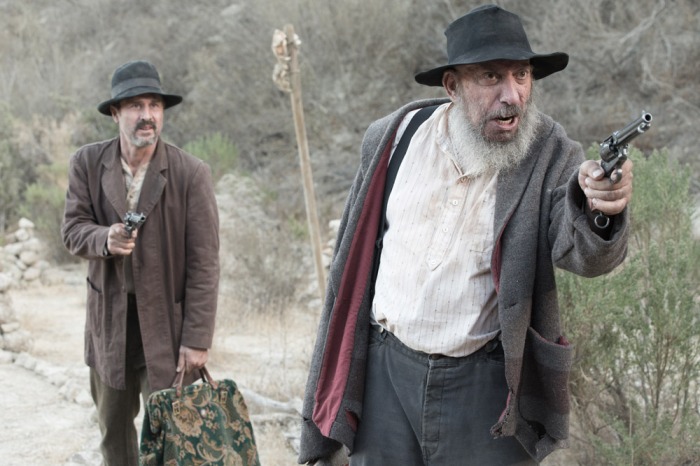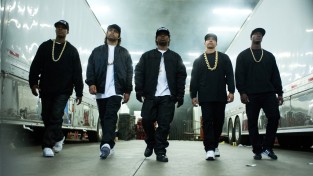| Home | Reviews | About | Contact Us |
(3/3/16)
“Bone Tomahawk grants itself vigorously on subject matter, music, acting, and locations”
Alas, it’s once again another time where I get the opportunity to dissect and become discursive about a genre which is particularly growing on me: the western. For a genre which primarily died out commercially after the 1960’s, having the entitlement of seeing the occasional modern western here and there is certainly a privilege in this day and age. I cherish them – I adore the likes of 3:10 to Yuma (2007) and somewhat The Homesman (2014). Half of today’s cinema goers have little understanding about spaghetti, supernatural, or neo-westerns, and even with Tarantino more or less at the helm of current westerns, that precedent probably won’t change for a while. What makes Bone Tomahawk give that extra curve is that is infuses a deep horror element to it, spiraling from other horror-westerns such as Ravenous (1999) and the more recent The Hateful Eight (2015), which you can see my review of here.
The very premise of Bone Tomahawk entails the story of a group of captives who are abducted in the small yet seemingly innocent town of Bright Hope. Mystery surrounds as to who specifically captured them and why, and consequently, a rescue mission is considered by the town’s sheriff Franklin Hunt (Kurt Russell) along with three others. A feral arrow perched in the town’s jail the following morning is linked to a troglodyte clan, essentially cave dwellers who feast on humans. After speculating that their encampment could be the “Valley of the Starving Man”, the riders set off. As they embark on an approximate 5 day ride, some scenes are swept with those gorgeous riding shots, which focus on the environments and hallowing silhouettes. For it’s limited budget, Bone Tomahawk capitalizes more on the scenery than scene. But that doesn’t mean it’s bereft of substance. Along the way, various tropes and decadents encounter the frontier men as they dwell into the deep West, often encountering raiders and thieves. We begin to understand the surreal lives of our rescuers and are bestowed their situations.
Like the director Steve McQueen, Bone Tomahawk’s subtle use of music produces a distilling yet effective contrast to the audio-visual relationship. Bone chilling strings are enacted as the frontiers ride into the unexpected. As touched upon, for a movie that had an eagerly low budget of just under $2 million, almost everything is crafted solidly within it’s means, particularly the music. However, there were a few traits in the movie I personally thought staggered, such as the editing and lack of tension, primarily as it’s a horror. It felt far too clunky during the culminating action scenes and choreographically feeble, which subsequently zipped me out of the immersion. Granted, only so much could be done due to obvious reasons, but it could have been eluded if certain techniques were adopted (such as fast-paced editing when necessary or perhaps, although already great, more music to build that real sense of scare). Some ideas put forth were just too lacklustre to comprehend. One thing that is commendable is the hair, makeup, and the all round prosthetic element of the picture. It’s absolutely fantastic to which how some stuff was conceived considering it’s a movie which includes festering cannibals.
It’s also impressive to see Russell once again somewhat make a comeback to acting with a surprisingly high turnout of three roles in 2015, two of those being westerns. As always it’s so refreshing to see such an enigmatic actor, but ultimately it was Patrick Wilson whose performance swept me away in this picture. He is the one who goes through the most endurance and emotion throughout, and he executes it wondrously. Admittedly I have only seen him in a few other roles and know very little about his filmography, but his acting achievements in Bone Tomahawk has certainly merited my respect for him. He, in my opinion, is the apex of this feature.
Regardless to say, not much more can be said about Bone Tomahawk. It grants itself vigorously on subject matter, music, acting, and locations, and although it stumbles on a few directorial and editorial faults, Bone Tomahawk would still be a firm recommendation for the likes of independent features and western types. As we have already scuttled over the picture’s achieving budget and it’s limitations, I must once again profess my admiration for how everything ceded together so prudently. Films like this are to express aspirations for those who wish to forefront the movie production process and what can be done in certain circumstances. Bravo, S. Craig Zahler!
Matthew Alfrey
| Home | Reviews | About | Contact Us |






